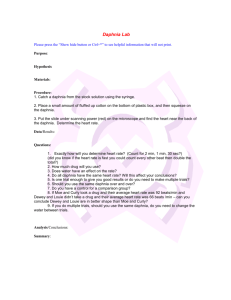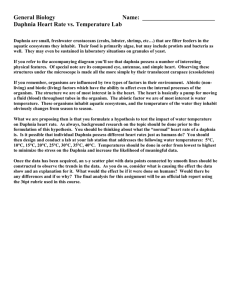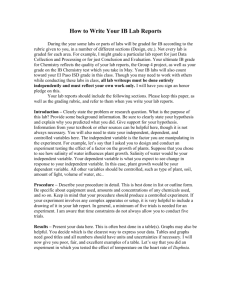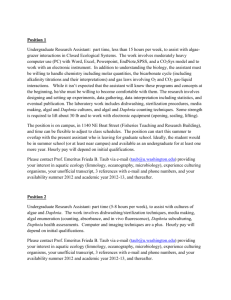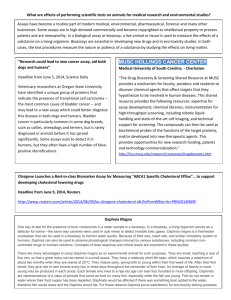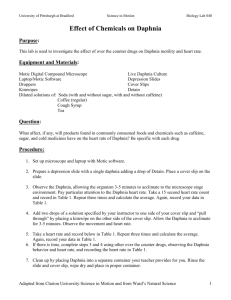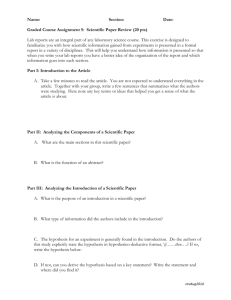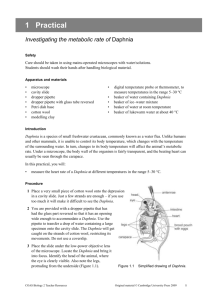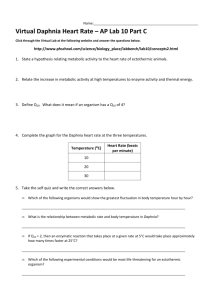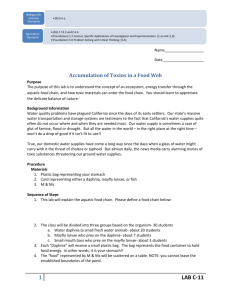Daphnia Heart Rate
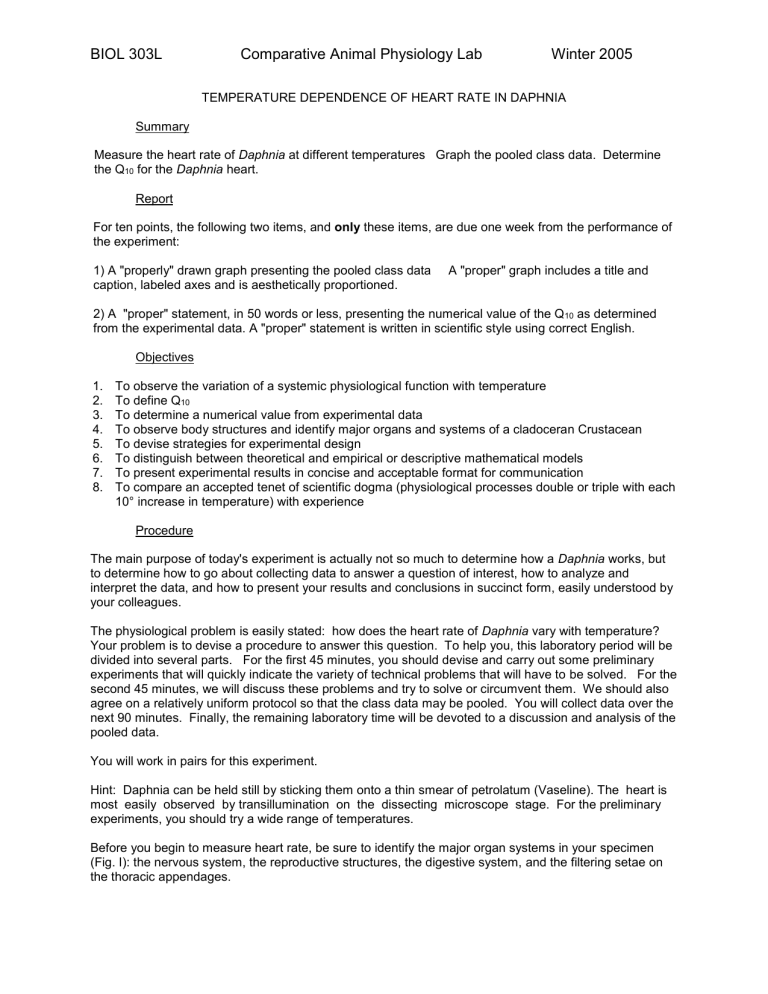
BIOL 303L Comparative Animal Physiology Lab Winter 2005
TEMPERATURE DEPENDENCE OF HEART RATE IN DAPHNIA
Summary
Measure the heart rate of Daphnia at different temperatures Graph the pooled class data. Determine the Q
10
for the Daphnia heart.
Report
For ten points, the following two items, and only these items, are due one week from the performance of the experiment:
1) A "properly" drawn graph presenting the pooled class data A "proper" graph includes a title and caption, labeled axes and is aesthetically proportioned.
2) A "proper" statement, in 50 words or less, presenting the numerical value of the Q
10
as determined from the experimental data. A "proper" statement is written in scientific style using correct English.
Objectives
1. To observe the variation of a systemic physiological function with temperature
2. To define Q
10
3. To determine a numerical value from experimental data
4. To observe body structures and identify major organs and systems of a cladoceran Crustacean
5. To devise strategies for experimental design
6. To distinguish between theoretical and empirical or descriptive mathematical models
7. To present experimental results in concise and acceptable format for communication
8. To compare an accepted tenet of scientific dogma (physiological processes double or triple with each
10° increase in temperature) with experience
Procedure
The main purpose of today's experiment is actually not so much to determine how a Daphnia works, but to determine how to go about collecting data to answer a question of interest, how to analyze and interpret the data, and how to present your results and conclusions in succinct form, easily understood by your colleagues.
The physiological problem is easily stated: how does the heart rate of Daphnia vary with temperature?
Your problem is to devise a procedure to answer this question. To help you, this laboratory period will be divided into several parts. For the first 45 minutes, you should devise and carry out some preliminary experiments that will quickly indicate the variety of technical problems that will have to be solved. For the second 45 minutes, we will discuss these problems and try to solve or circumvent them. We should also agree on a relatively uniform protocol so that the class data may be pooled. You will collect data over the next 90 minutes. Finally, the remaining laboratory time will be devoted to a discussion and analysis of the pooled data.
You will work in pairs for this experiment.
Hint: Daphnia can be held still by sticking them onto a thin smear of petrolatum (Vaseline). The heart is most easily observed by transillumination on the dissecting microscope stage. For the preliminary experiments, you should try a wide range of temperatures.
Before you begin to measure heart rate, be sure to identify the major organ systems in your specimen
(Fig. I): the nervous system, the reproductive structures, the digestive system, and the filtering setae on the thoracic appendages.
BIOL 303L Comparative Animal Physiology Lab Winter 2005
Figure 1: Anatomy of female Daphnia pulex (De
Geer) (greatly magnified); diagrammatic; (muscles not shown in fig 1). B , brain; BC , brood chamber; C , digestive caecum; CE , compound eye; F , fornix; FA , first antenna (antennule); H , heart; INT , intestine; O , ocellus; OV , ovary; R , rostrum or beak; SG , shell gland. Figure from John Clare, An Aquarist’s Guid
(www.caudata.org/daphnia/)
Arrhenius plot of Daphnia heart rate and respiratory movements. Data from Stier and
Wolf, 1932, J. Gen. Physiol 16:367, Figure from
Barnes, 1937, Textbook of General Physiology.
Blakiston, Philadelphia.
About Daphnia :
Phylum Arthropoda, SubPhylum Crustacea, Class Branchiopoda, Superorder Diplostraca, Order
Cladocera
Resources daphnia.com/daphnia.html ebiomedia.com/gall/classics/Daphnia/daphnia_gen.html www.microscopyu.com/moviegallery/pondscum/crustacean/daphnia/

